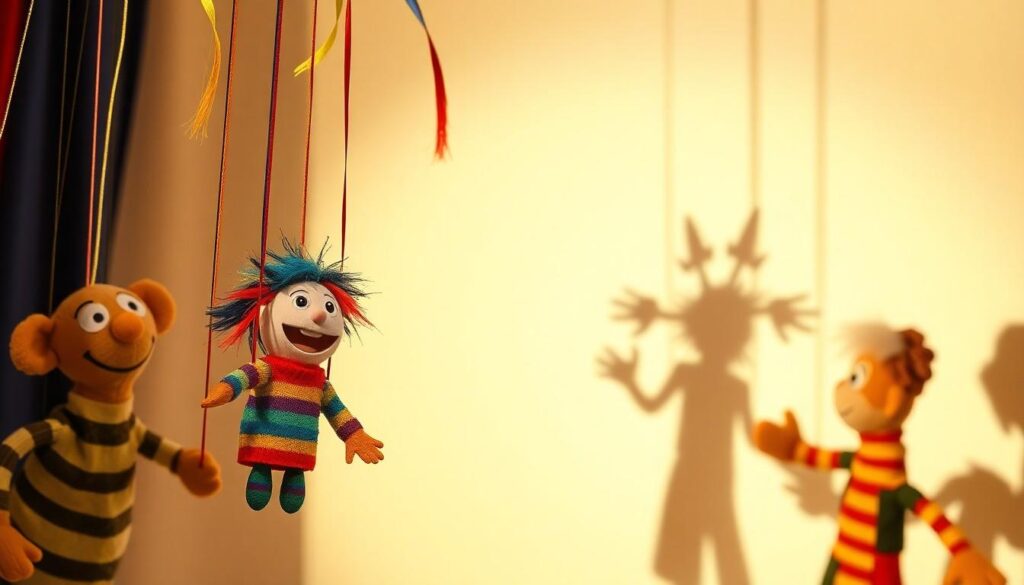Looking for a laugh that’ll have you in stitches? Puppet puns are the perfect way to pull some strings of humor into your day! We’ve gathered the most hilarious puppet-themed wordplay that’ll make even the most serious puppeteer crack a smile.
From marionettes to sock puppets, the industry of puppetry offers endless opportunities for clever wordplay. Whether you’re a professional puppeteer or just someone who appreciates a good pun, our collection will help you master the art of puppet-related humor. We’ll share puns that are appropriate for all ages, making them perfect for puppet shows, birthday parties, or just brightening someone’s day.
10 Puppet Puns That Will Have You Pulling Strings With Laughter
- I’m just pulling your strings – Use this classic puppet pun when you’re teasing someone or playing a joke. Everyone recognizes this idiom that cleverly references how puppeteers control their puppets.
- You’ve got me all tied up in knots – Perfect for expressing confusion or feeling overwhelmed, this pun works on multiple levels with its reference to tangled puppet strings.
- That’s a sock it to me moment – When something impressive happens, this sock puppet inspired pun delivers the perfect punch line for puppet enthusiasts.
- Stop being such a dummy – A playful jab referring to ventriloquist dummies that works wonderfully in light-hearted banter among friends who appreciate puppet humor.
- You’re quite the puppet master at this – Compliment someone’s excellent control or management skills with this pun that acknowledges their expertise, just like a skilled puppeteer.
- I’m at the end of my rope – Express frustration or exhaustion with this pun that cleverly references marionette control rods while conveying your emotional state.
- Let’s face it, you’re hand made for this job – Recognize someone’s natural talent with this hand puppet reference that works especially well for crafty or artistic individuals.
- Seems like we’re all dancing to the same tune – Use this marionette-inspired pun when everyone’s following the same instructions or working in harmony.
- You’ve really got your hand in everything – This puppet pun works perfectly when describing someone who’s involved in multiple projects or situations, reminiscent of how puppeteers animate their creations.
- That conversation felt like a puppet show – Deploy this pun when describing a situation where someone else seemed to control the entire interaction, just like a puppeteer controls their performance.
No Strings Attached: The Art Of Puppetry Wordplay

Puppet puns are clever wordplay that revolves around puppets and puppetry, creating humor that appeals to audiences of all ages. Let’s explore some delightful examples of puppetry wordplay that’ll make you smile!
Marionette Jokes That Won’t Leave You Hanging
Marionette puns truly know how to string together humor and creativity. These jokes play on the distinctive strings and movement of marionettes, offering playful twists that puppet enthusiasts love. For example, “I love my marionette, it really knows how to string me along” delivers a perfect play on words about puppet manipulation. Many puppeteers incorporate these witty remarks during shows to engage their audience with humor. Marionette jokes work exceptionally well in children’s performances where they create entertaining moments that keep young viewers captivated. Professional puppeteers often use phrases like “Life is better with a puppet in hand” to establish rapport with their audience while showcasing their create.
Hand Puppet Humor To High-Five About
Hand puppet humor creates an immediate connection with audiences through its accessibility and relatability. These puns focus on the direct manipulation aspect of hand puppets, making them perfect for interactive performances. Popular examples include “A puppet’s favorite exercise is pull-ups” and “Puppets know how to tie friendships together,” which cleverly reference the physical aspects of puppetry. Hand puppet jokes excel in educational settings where they combine entertainment with learning—a concept known as “edutainment.” Performers often use the comedic ever-changing where the puppet delivers the punchline while the puppeteer acts as the straight man. This approach adds depth to performances and helps create memorable experiences for viewers of all ages. Many puppeteers incorporate questions like “Why did the puppet go to school? To improve its skills!” to encourage audience participation and engagement during shows.
Pull The Right Strings: Puppet Puns For Every Occasion
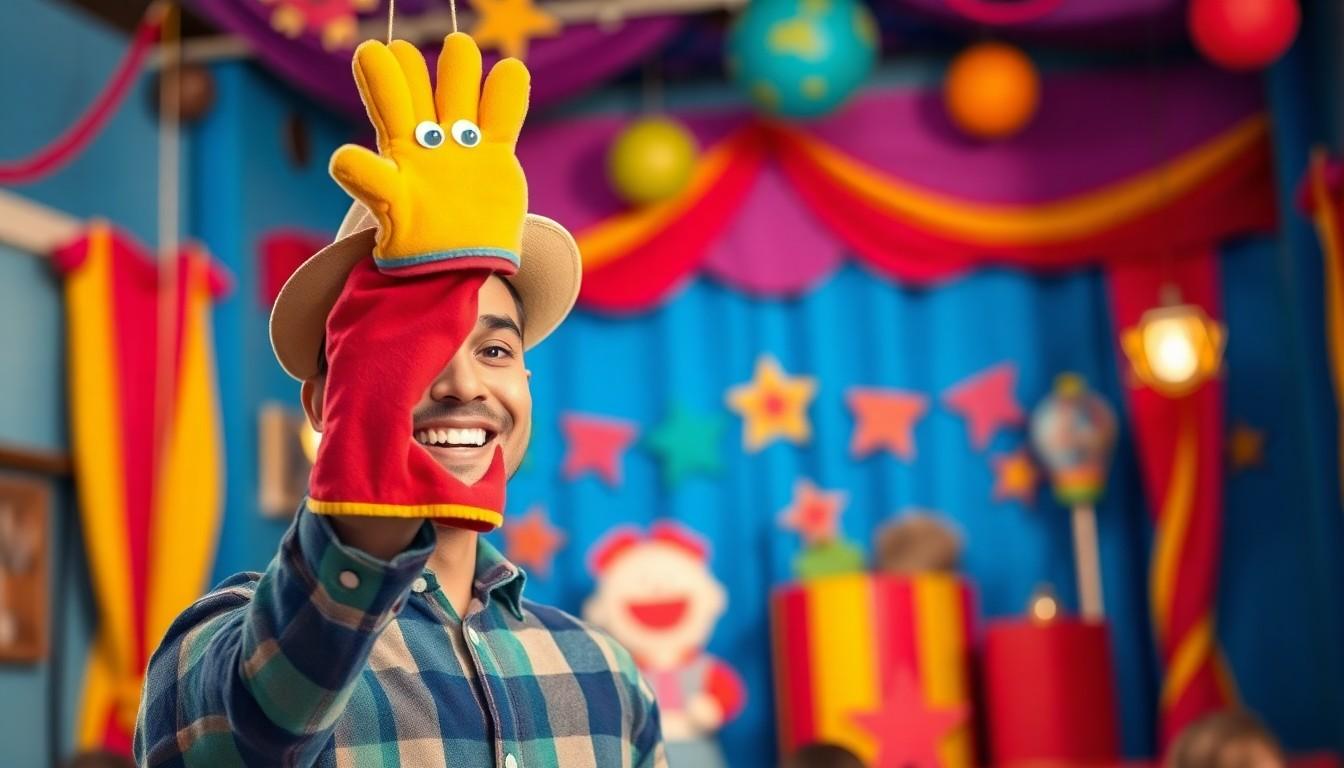
Ice Breakers For Puppet Shows
Starting your puppet show with a clever pun can instantly set a light-hearted tone and capture your audience’s attention. We’ve found that puppet puns work exceptionally well as ice breakers, especially when performing for children or mixed audiences. Try opening with “Puppets never get lost, they follow the right strings” to get those initial chuckles flowing. Character introductions become memorable when you incorporate wordplay like “My puppet has great potential for humor” or “Why did the puppet go to school? To improve its skills.” For interactive segments, consider using puns as part of a game where audience members correct the puppet’s misinterpretation of a classic fairy tale. These playful linguistic twists not only warm up the crowd but also establish an immediate connection between your puppets and viewers.
Social Media Captions That Manipulate Laughter
Puppet puns make perfect captions for your social media posts, generating engagement and spreading joy across your platforms. We recommend using phrases like “Feeling a bit puppet-ized today 🧸✨” for those casual selfies with your puppet creations. For performance announcements, try “Let’s string along with the fun 🎉” to build anticipation. Sharing behind-the-scenes content? Caption it with “Life is better with a puppet in hand. #PuppetLove #Laughter” to convey your passion. Friend collaborations deserve something like “Puppets know how to tie friendships together. #PuppetPals” to celebrate your creative partnerships. Action shots of puppets in motion pair wonderfully with “A puppet’s favorite exercise is pull-ups. #PuppetHumor” to showcase your wit. These captions not only enhance your posts but also help build a distinctive brand voice that puppet enthusiasts will come to recognize and appreciate.
Sock It To Me: Hilarious Sock Puppet One-Liners
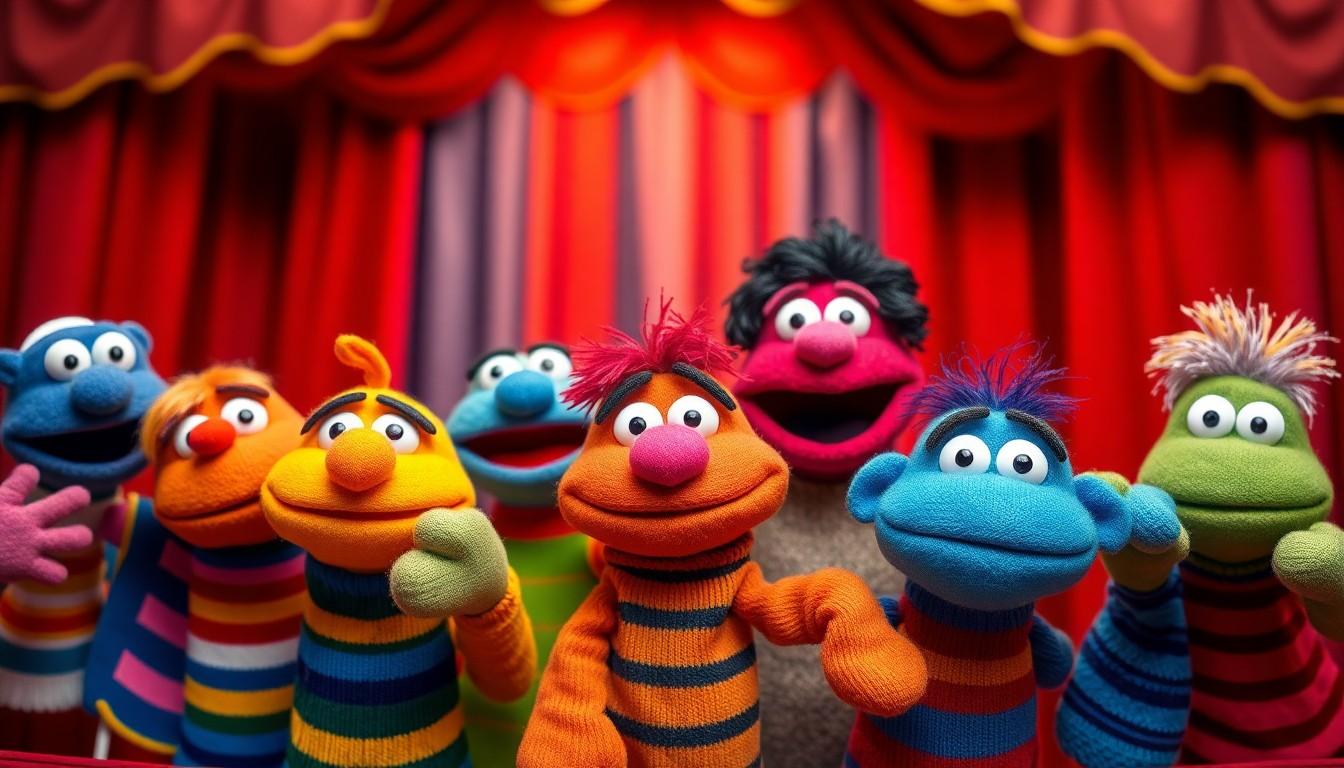
Sock puppets have their own special brand of humor that’s guaranteed to make audiences laugh. These simple creations made from everyday footwear offer endless opportunities for clever wordplay and visual comedy. We’ve gathered some of the most entertaining sock puppet one-liners that will have your friends and family in stitches.
Food for Thought
Sock puppets have quite the appetite when it comes to humor. The question “What do sock puppets eat?” has a delightfully simple answer: finger foods! This pun works on multiple levels, playing on the fact that human fingers operate these fabric friends. Your audiences will appreciate this tasty bit of wordplay during any puppet performance.
Identity Crisis
Nothing’s funnier than sock puppet identity jokes. When asked “What do you call a faceless sock puppet?” the answer “A mitten” lands perfectly every time. This clever observation highlights the transformation between everyday items while delivering a punch of humor. Kids especially find this comparison hilarious as they visualize the difference between their winter wear and puppet friends.
Helping Hands
Sock puppets excel at offering assistance with a side of humor. A classic line has one sock puppet saying to another: “You look like you could use a hand.” This pun brilliantly references both the helping nature of friendship and the physical reality of how sock puppets function. It’s perfect for incorporating into dialogues between puppet characters during performances.
Refund Request
Customer service gets the sock puppet treatment with this gem: “Why did the man demand a refund after going to a sock puppet theatre? Because it was a show of hands.” This play on the phrase “show of hands” demonstrates how sock puppet humor often relies on dual meanings. The visual imagery makes this joke particularly effective when told with animated gestures.
Basketball Star
Sock humor stretches beyond puppetry with this sporty one-liner: “What do you call a 7-foot-tall sock that can dunk a basketball? Sockille O’Neal!” This pun cleverly combines the industry of sports with sock-related wordplay, making it perfect for captivating audiences with diverse interests. Sports fans particularly appreciate this reference to the basketball legend Shaquille O’Neal.
Employment Issues
Even sock puppets face workplace challenges as evidenced by this joke: “Why did the ankle socks get fired from their job? They were no-shows.” This pun works brilliantly by playing on the term “no-show” socks while creating a workplace scenario everyone can relate to. It’s an excellent addition to any sock puppet comedy routine focusing on everyday situations.
New Beginnings
Optimism shines through in this sock-related quip: “What did one new sock say to the other? Great things are afoot.” The play on “afoot” cleverly incorporates the sock’s natural habitat while expressing excitement about future possibilities. This positive message wrapped in wordplay makes it ideal for uplifting puppet show moments or transitions between scenes.
Ventriloquist Humor: When Your Dummy Is The Funny One
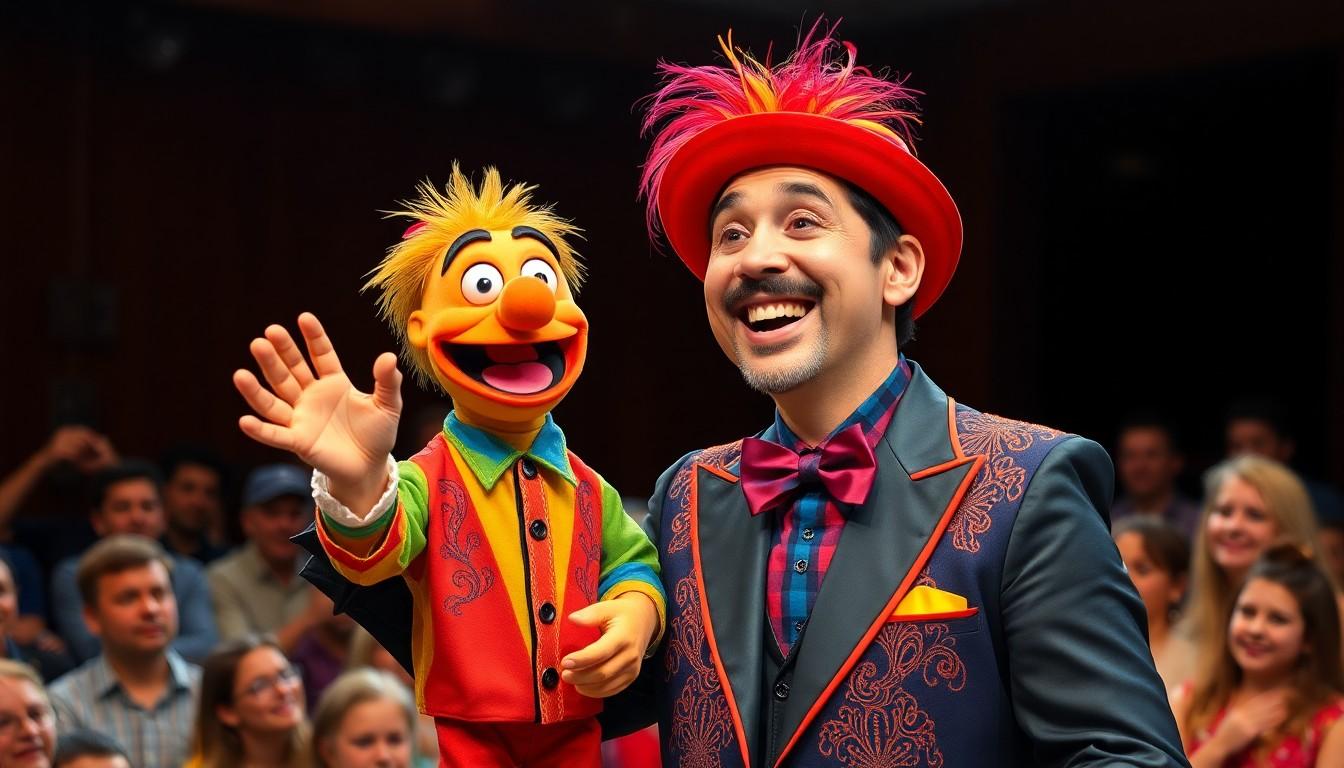
Ventriloquist humor represents a unique subset of puppet comedy where the dummy becomes the star of the show. Professional ventriloquists rely heavily on puppet puns to create captivating performances that captivate audiences of all ages. The art combines skillful voice throwing with clever wordplay to make it appear as if the puppet itself is delivering the jokes.
The Perfect Partnership
The ventriloquist-dummy relationship creates an ideal setup for comedy, allowing performers to deliver puns through their puppets. Many successful acts use phrases like “I’m feeling a bit puppet-ized” or “Let’s string along with the fun!” to establish their puppet’s personality. This ever-changing enables performers to play with audience expectations by setting up jokes that the dummy can then deliver with perfect timing.
Creating Character Through Wordplay
Ventriloquists often develop their dummy’s character through consistent use of puppet-related wordplay. The wooden puppet might complain about being “wooden” in social situations or mention how they’re always getting “strung along” by the ventriloquist. These puns work especially well because they incorporate the physical reality of the puppet into the humor, making the jokes feel more authentic and entertaining.
Audience Engagement Techniques
Captivating the audience becomes much easier when ventriloquists incorporate puppet puns into their act. A ventriloquist might have their dummy exclaim, “This show is off the charts, it’s a real string-pull of talent!” to acknowledge an enthusiastic audience. These interactive moments create memorable experiences for viewers and help establish a connection between the puppet character and the audience.
Teaching Through Humor
Ventriloquist acts often serve educational purposes, with the dummy asking questions that children might be wondering. The use of puns in these educational segments helps maintain attention while delivering information in an entertaining format. The puppet’s innocent curiosity paired with clever wordplay creates a learning environment that doesn’t feel like traditional instruction.
Multi-Generational Appeal
Puppet puns in ventriloquist acts appeal to both children and adults simultaneously. While kids enjoy the silly character and visual humor, adults appreciate the cleverness of the wordplay. This dual-layer approach allows ventriloquists to create shows that entire families can enjoy together, with humor that works on multiple levels.
Muppet-Inspired Puns That Kermit Would Approve
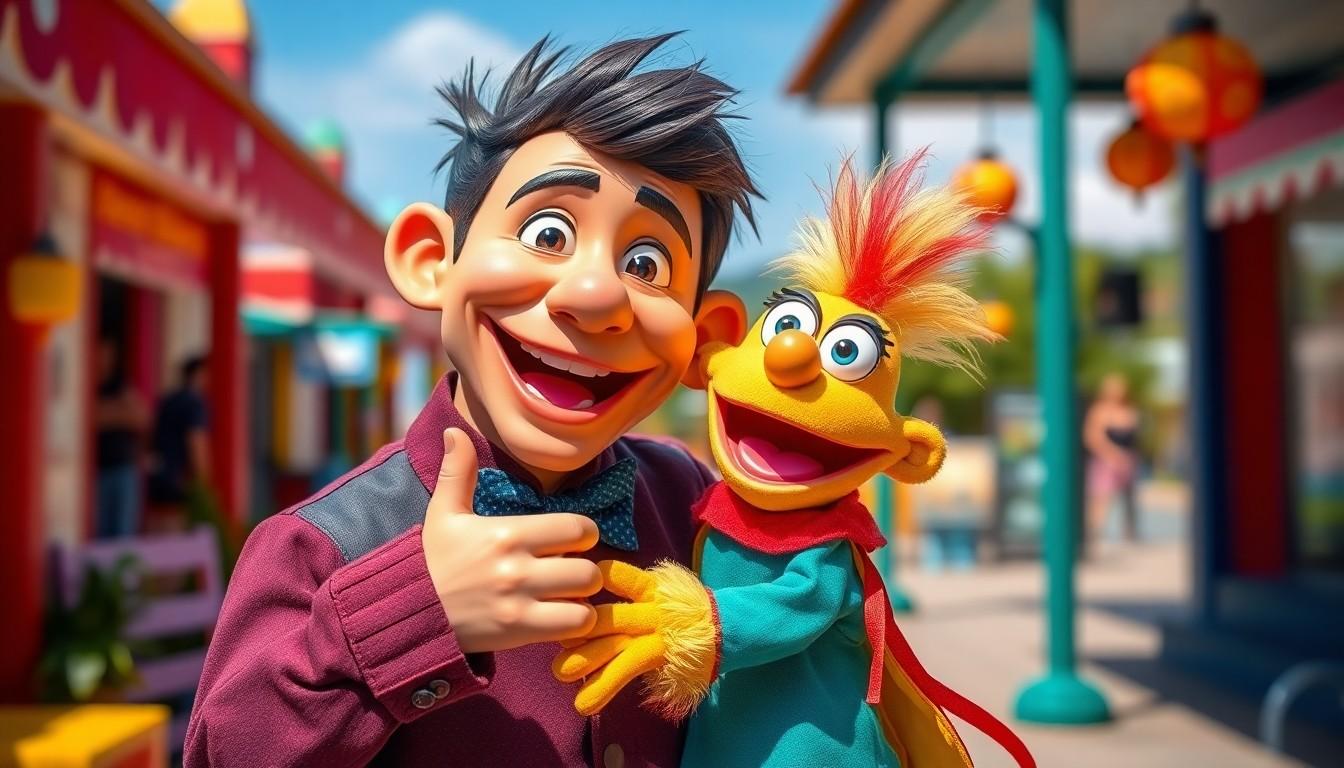
One-Liners That Pack a Puppet Punch
Puppet potential knows no bounds when it comes to wordplay! “Why did the puppet go to school? To improve its puppet-tential!” This classic one-liner captures the essence of Muppet humor that Kermit would surely appreciate. Many puppet enthusiasts love using the line “I’m really good at puppetry; I just pull the strings!” when showing off their skills. Fans of improvisational comedy might enjoy telling friends that “Puppets are great at improv; they really know how to wing it!” Comedy-loving puppets have their own special designation: “What do you call a puppet that tells jokes? A pun-derful friend!” Relationship woes aren’t off-limits either with gems like “Why did the puppet break up with its partner? They just couldn’t find common strings!”
Everyday Activities With a Puppet Twist
Outdoor adventures take on new meaning in the puppet industry, where “When puppets go camping, they’re naturals at pitching tents – no strings needed!” Career changes often require flexibility, as evidenced by “When the puppet got a job at the bakery, he kneaded a little more dough.” Fitness routines get a stringy makeover too: “How do puppets stay in shape? They do a lot of marionette-ics!” These activity-based puns bring puppet characters to life in everyday scenarios, making them relatable and entertaining for audiences of all ages.
Character Traits That String You Along
Physical characteristics of puppets provide endless pun opportunities that would make Kermit chuckle. “Puppets don’t sweat; they have someone else pull their strings in a workout!” Personal secrets take on new meaning when “Puppets don’t have skeletons in the closet, they have strings in the attic!” Social popularity comes naturally to some puppets because “Why was the puppet always invited to parties? He knew how to pull the right strings!” These characteristic-based puns highlight the unique nature of puppets while delivering laughs.
Humor That Gets You In Stitches
Puppet shows create their own comedy category with fans often saying “Puppet shows always get me in stitches!” Appreciating a puppet’s comedic talent can be expressed with “My puppet has a great sense of humor; it really knows how to string a joke together!” Fabric-based humor has its own special quality, as “Puppets may be made of fabric, but their jokes are always sew good!” These meta-humor puns celebrate the joy puppets bring through their performances.
Random Puppet Wisdom
Card games present unique challenges in the puppet industry: “Why did the puppet refuse to play cards? It was afraid of getting stringed along!” Audience appreciation comes with its own puppet perspective: “What did the puppet say to its audience? You really know how to string me along!” Ambition knows no bounds when “Why did the puppet bring a ladder to the show? He wanted to reach new heights in performance!” These miscellaneous puns round out our collection with versatile options that would make even the most stoic puppet crack a smile.
Puppetry Punchlines: International Puppet Jokes
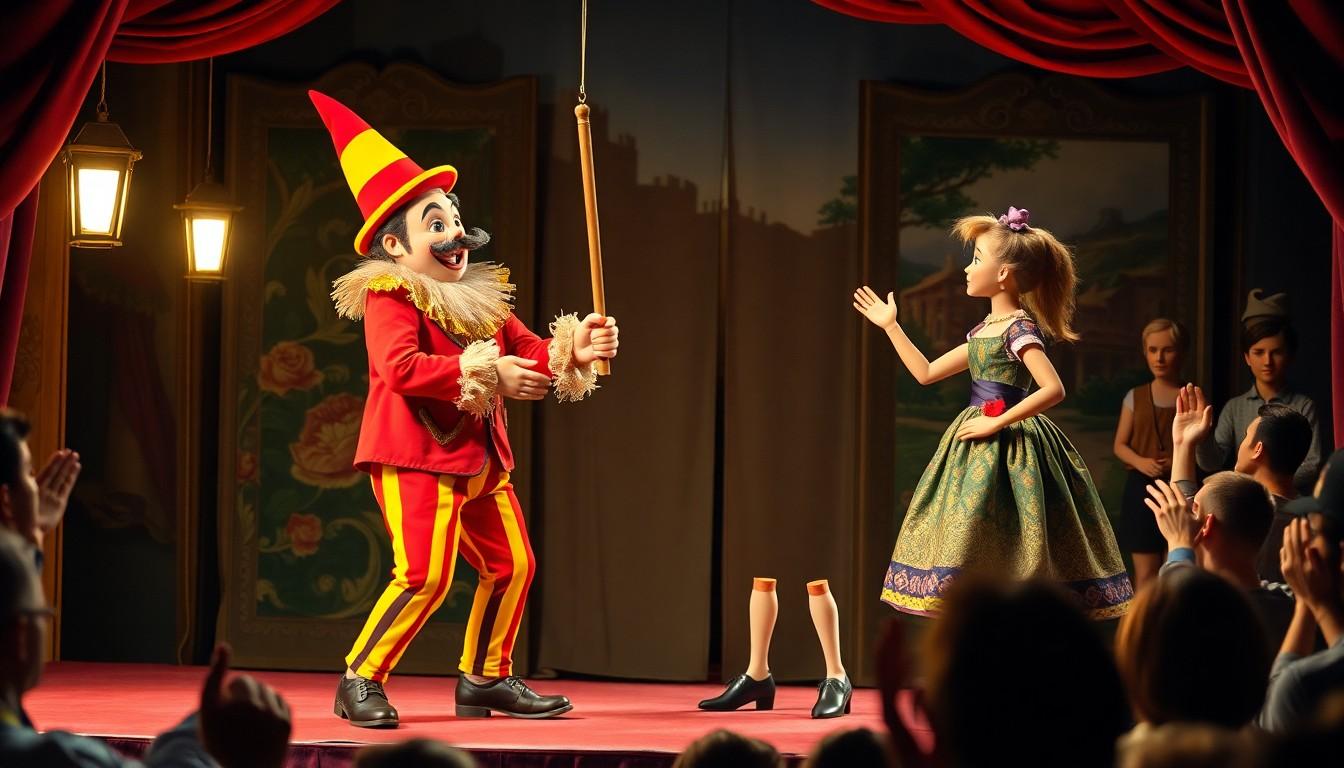
Puppet humor transcends borders, with each culture bringing its unique twist to puppetry comedy. Let’s explore how different regions around the industry incorporate wordplay and jokes into their puppet traditions.
European Puppet Tradition Laughs
European puppet shows have mastered the art of combining humor with storytelling for centuries. The iconic Punch and Judy shows represent the pinnacle of British puppet comedy, featuring slapstick humor and witty dialogue that has entertained audiences since the 17th century. Punch’s characteristic voice and catchphrases create immediate laughter, while his interactions with Judy and other characters showcase clever wordplay that resonates with viewers of all ages.
These traditional shows often include jokes like: “Punch always hits the right note with his audience—usually with his stick!” or “Why did Judy leave Punch? She couldn’t handle his string of bad jokes!” These performances cleverly use humor to engage audiences while sometimes conveying social commentary beneath the surface of the comedy.
In Italian puppetry tradition, Pulcinella offers similar comedic appeal with region-exact jokes and puns that reflect local customs and social structures. The French character Guignol continues this tradition with humor that’s both sophisticated and accessible. European puppet comedy demonstrates how humor, when paired with puppetry, creates memorable entertainment that has endured for generations.
Asian Puppet Arts Wordplay
Asian puppet traditions incorporate humor that’s deeply rooted in cultural contexts and linguistic nuances. Japanese Bunraku puppetry, even though its serious dramatic elements, often includes moments of clever wordplay that highlight the puppeteers’ skill and the characters’ personalities. The coordination of multiple puppeteers controlling a single puppet creates opportunities for physical comedy that transcends language barriers.
Chinese shadow puppetry utilizes silhouettes to tell stories filled with humor that often plays on visual puns as well as verbal ones. A common joke in these performances might translate to: “The shadow puppet said he was feeling flat today—he needed to step into the light!” Indonesian wayang kulit performances frequently incorporate jokes about current events and local politics, making each show uniquely relevant to its audience.
Vietnamese water puppetry adds another dimension to puppet humor with jokes about characters emerging from and splashing in water: “What does a water puppet use to dry off? A micro-fiber cloth!” These traditions demonstrate how puppet humor adapts to cultural contexts while maintaining the universal appeal of clever wordplay and visual gags that make audiences laugh across language barriers.
String Theory: Science Meets Puppet Humor

String Theory in physics attempts to reconcile quantum mechanics with general relativity, but in the industry of puppetry, it takes on a humorously literal meaning. We’ve discovered that puppet puns can cleverly bridge the gap between scientific concepts and puppet humor, creating a unique blend of intellectual and playful entertainment.
Puppeteers often joke that they’re “quantum physicists of entertainment” because they understand the true meaning of String Theory. Many performers use strings as both physical tools and metaphorical devices for humor, such as “This puppet show is off the charts, it’s a real string-pull of talent.” The physical connection between puppeteer and puppet provides endless opportunities for wordplay that audiences of all ages can appreciate.
Creative string-themed puns work particularly well in educational settings where “edutainment” helps with memory retention. “Puppets never get lost, they follow the right strings” serves as both a clever joke and a memorable line that reinforces the connection between puppets and their manipulation. Puppet shows that incorporate these science-meets-strings jokes often see higher engagement levels, especially when the humor appeals to both children and adults.
Professional puppeteers frequently use phrases like “I love my puppet, it really knows how to string me along” to establish rapport with their audience. The beauty of these string-based jokes lies in their accessibility—they don’t require complex scientific knowledge to appreciate, yet they nod cleverly to the more sophisticated concept of String Theory. This dual-layer approach makes puppet puns versatile tools for various performance contexts, from birthday parties to educational programs.
Exploring the tension and release that strings provide creates another dimension of humor in puppetry. Just as String Theory in physics explores fundamental tensions in the universe, puppet humor examines the delightful tension between inanimate objects and the lifelike qualities they assume under skilled manipulation. These puns aren’t just throwaway jokes—they’re carefully crafted elements that enhance the overall puppet experience while providing light-hearted entertainment that resonates across generational divides.
Shadow Puppet Puns That Cast A Spell Of Giggles

Shadow puppetry offers a perfect backdrop for some illuminating wordplay that’ll leave your audience in stitches. We’ve gathered the most shadowy and giggle-worthy puns that play with light, darkness, and the art of shadow manipulation.
Shadowplay Wordplay
- “What did one shadow puppet say to another? You’re looking a bit shady today!”
- “Shadow puppets don’t have skeletons in the closet, they have strings in the attic!”
- “Why do shadow puppets make great friends? They always stick by your side, even in the darkest times!”
- “The puppet tried to make a comeback, but it just couldn’t get its strings back in line.”
Light-Hearted Shadow Jokes
- “How do shadow puppets stay in shape? They do a lot of shadow boxing and marionett-ics!”
- “What’s a shadow puppet’s favorite movie? The Dark Knight!”
- “Why was the shadow puppet always invited to parties? It knew how to pull the right strings and never overshadowed the host!”
- “You’ve got me in stitches like a puppet’s seams when you cast those shadow figures.”
Illuminating One-Liners
- “Why did the shadow puppet break up with his girlfriend? He just couldn’t string her along anymore in the spotlight!”
- “When the shadow puppet got a job at the bakery, he kneaded a little more dough to cast bigger shadows.”
- “What’s a shadow puppet’s favorite type of music? String music with a dark twist, of course!”
- “Life’s better when you’re pulling strings behind the shadow screen.”
Behind-the-Screen Humor
- “I’m really good at shadow puppetry,” said the marionette, “but I can’t seem to pull it off without a light source!”
- “When puppets go camping, they’re naturals at creating shadow stories around the campfire – no strings needed!”
- “Why did the shadow puppet go to therapy? He had too many emotional strings attached and couldn’t face his dark side!”
Pulling It All Together: Creating Your Own Puppet Puns
We’ve strung together quite the collection of puppet puns spanning various traditions from marionettes to sock puppets and even shadow puppetry. These witty wordplays aren’t just for professional puppeteers – they’re for anyone looking to add humor to their day.
Next time you’re crafting social media captions putting on a show or simply chatting with friends don’t hesitate to pull some strings and drop a puppet pun. The joy of puppet humor lies in its accessibility and ability to connect across generations.
Remember the best puppet puns come from playing with concepts like strings control movement and character traits. So go ahead and create your own puppet jokes – you’ll have audiences in stitches!
Frequently Asked Questions
What are puppet puns?
Puppet puns are humorous wordplay that cleverly incorporate puppetry terminology into everyday expressions. They range from string-related jokes about marionettes to hand puppet humor and sock puppet one-liners. These puns appeal to both professional puppeteers and casual fans, making them perfect for puppet shows, birthday parties, or simply adding laughter to daily conversations.
How can puppet puns be used in performances?
Puppet puns work excellently as ice breakers at the beginning of shows, during character introductions, or as transitional material between segments. They help establish a light-hearted tone, engage audiences, and create memorable moments. Many professional puppeteers incorporate puppet-specific wordplay to enhance their performances and build rapport with viewers of all ages.
Are puppet puns appropriate for children?
Yes! Most puppet puns are family-friendly and designed to appeal across generations. They provide clean humor that children can understand while often containing cleverness that adults appreciate. Educational settings frequently use puppet puns to make learning more engaging and fun, helping children connect with the material in a memorable way.
What kinds of puppet styles have their own specific puns?
Several puppetry styles feature unique puns: marionettes (string-based humor), hand puppets (finger and hand jokes), sock puppets (foot-related comedy), ventriloquist dummies (voice and conversation puns), shadow puppets (light and darkness wordplay), and Muppet-inspired puns. Each style offers distinct opportunities for creative wordplay based on their particular characteristics.
How do puppet puns work in social media?
Puppet puns make excellent social media captions that generate engagement and spread joy. They’re short, memorable, and often visually oriented, making them perfect companions to puppet photos or videos. Content creators in the puppetry community frequently use these puns to connect with followers and build their brand with consistent, themed humor.
Do different cultures have their own puppet humor?
Absolutely! Puppet humor varies widely across cultures. European traditions like Punch and Judy incorporate slapstick with clever dialogue, while Asian puppet arts such as Japanese Bunraku and Chinese shadow puppetry utilize cultural contexts and visual puns. Vietnamese water puppetry features unique humor related to water elements, showing how puppet wordplay adapts to different cultural contexts.
What is “String Theory” in puppet humor?
“String Theory” in puppet humor playfully connects scientific concepts with puppetry terminology. These puns joke about puppeteers being “quantum physicists of entertainment” and create wordplay around the strings that control marionettes. This clever blend of science and puppetry makes complex ideas more accessible while providing entertainment that works on multiple levels of understanding.
How can beginners incorporate puppet puns into their routines?
Beginners should start with simple, universally understood puns like “I’m just pulling your strings” or “You’ve got me all tied up in knots.” Practice timing and delivery with friends before performing publicly. Begin by incorporating 2-3 puns naturally into your routine, and observe audience reactions to refine your approach. Remember that authentic delivery often works better than forcing too many puns.

